Author: Josh Stark, Ethereum Foundation
Compiled by: Pzai, Foresight News
What happened to Ethereum in 2024?
We can divide it into three themes:
- Applications: The ecosystem of products and services built on Ethereum.
- Infrastructure: The technology that makes it all possible.
- Community: You, me, and everyone who uses or contributes to Ethereum.
Applications
Ethereum is changing the world because it solves problems for people. Developers around the globe are using Ethereum to build what users want. But Ethereum is not just one thing—it is a platform that serves a multitude of use cases. One of those use cases is stablecoins. Stablecoins give everyone the freedom to transact: sending money home to family or saving for the future. I believe they are still underestimated—stablecoins fundamentally enhance the freedom of humanity worldwide.
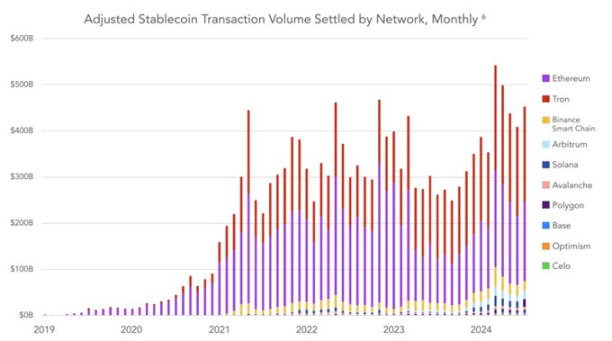
Stablecoins exist on many chains, but the Ethereum ecosystem plays a unique role as the circulation venue for most existing stablecoins. The number of stablecoins in the Ethereum ecosystem now competes with major payment processing networks, including Mastercard and Visa.

Behind all these statistics are a variety of stories and use cases. For example, Bitso uses stablecoins on Ethereum to provide faster and cheaper remittances in Latin America; Pintu leverages stablecoins to offer better savings products for users in Indonesia.
Ethereum is also the birthplace of DeFi. These applications utilize Ethereum's unique properties to build financial products that cannot be discriminated against or shut down, allowing people to have better control over their funds. DeFi was invented on Ethereum, and the Ethereum ecosystem remains its home. Today, about 60% of the value in DeFi applications is stored on Ethereum or Ethereum L2.

Behind these huge numbers are tangible benefits for ordinary people around the world. In Mexico, EthicHub connects small business owners, such as coffee producers, with lenders who provide the capital needed for their business growth through DeFi.
There is "more" DeFi on Ethereum that I cannot cover in this talk. Thanks to all the teams, companies, DAOs, and independent developers building this ecosystem. Stablecoins and DeFi are the two earliest use cases on Ethereum, and they continue to mature, grow, and scale. But Ethereum is also a blockchain ecosystem that generates new things.
New projects like social networks Farcaster, Lens, and Zora use Ethereum to give users control over their identities and even share in the growth of the platform. There are also new games using Ethereum technology to provide players with new experiences, such as EVE Frontier, a new MMO game where the physical properties of the game world are built in the form of smart contracts, allowing players to create autonomous systems.
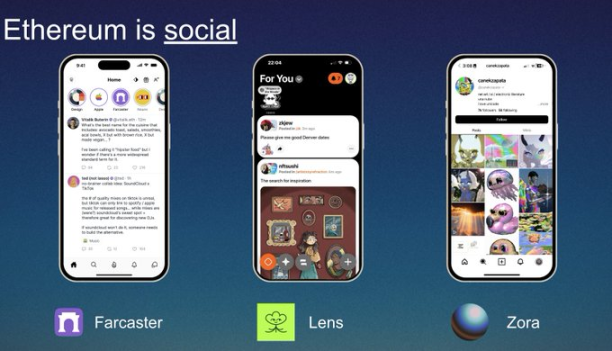
Decentralized identity systems, such as ENS and AnonAadhaar, provide users with options that centralized or traditional IDs do not offer. Real-world infrastructure, like Glow, utilizes the Ethereum ecosystem to incentivize hundreds of solar power plants.

The significant breakthrough success of prediction markets, such as Polymarket and the Polygon team, is demonstrating to the world the possibilities of building open systems on-chain. I am very excited about Polygon PoS soon completing its transition to Ethereum validation. One thing I love about the Ethereum ecosystem is that it is the place where ideas come into production. Prediction markets are an idea that has been formalized and debated in academic work for decades. It is on Ethereum that early experiments have led to breakthrough moments of success.

Quadratic funding is another idea that has been formally developed in academic work over the years. Then, multiple teams in the Ethereum ecosystem adopted these ideas and built products that serve users around the world today.
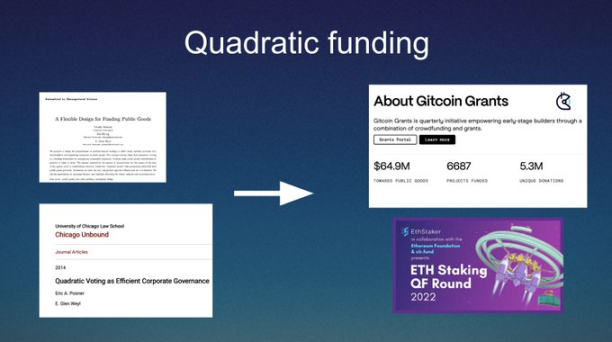
Ethereum is the platform for developers. By 2024, Ethereum will be the "best" platform for developers in the crypto ecosystem. This is even more evident when you look at the chain ecosystem data of what project founders are building or "interested" in building:

One important reason for this is the extremely deep and comprehensive developer tools ecosystem on Ethereum, which provides everything developers need to launch, deliver, and build applications that can scale securely to millions of users worldwide.
When we take a glance, what do we see in the application layer of Ethereum? Ethereum has the oldest and most mature use cases: currency, stablecoins, DeFi; Ethereum is also the birthplace of new things, and it has the best developer ecosystem. Looking around our ecosystem and seeing the confidence and excitement in every use case area, I can fairly say that Ethereum's goal is to maintain growth in every dimension.
Infrastructure
Behind every application is a technological layer, which includes Ethereum L1 and L2 networks. Over the past few years, the Ethereum ecosystem has made significant investments in improving this infrastructure. Ethereum is the only blockchain that has enough real demand and pushes it to the limit, requiring true scalability to be achieved without compromise, which is a daunting but necessary path.
Most of the investment is related to L2 or Rollups. I won't elaborate on this here, but I want to provide a very simple mental model that anyone can understand. The idea behind L2 is simple: the core is Ethereum L1—the native smart contract platform and the most secure blockchain in the world. But the "surface area" available for developers and users on L1 is limited, which means it can be relatively expensive. The outer layer is Ethereum L2, which are networks built "on top" of L1 and expand its surface area outward. L2 provides developers and users with more available space, thereby reducing costs, but because they can connect to Ethereum in specific ways, they are very secure.
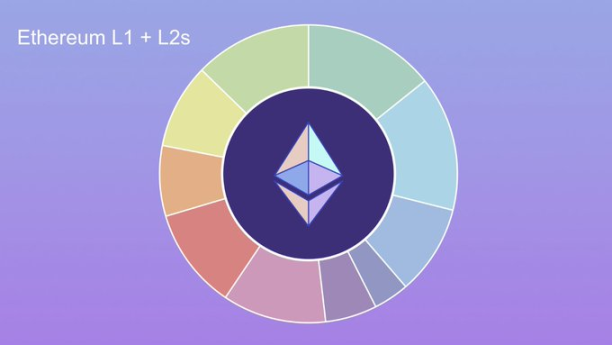
Now, we cannot be complacent—there is still much work to be done to complete the L2 roadmap of the ecosystem. But currently, we have some very strong evidence that this strategy is working.
The first piece of evidence is: people are using them! This year, the real TPS on Ethereum L2 has exploded, and the TVL in L2 has also increased. Meanwhile, after key network upgrades earlier this year, fees remain low (EIP 4844). On Ethereum L2, you can send $1, $100, or even $1 million to anyone on Earth for less than a cent.
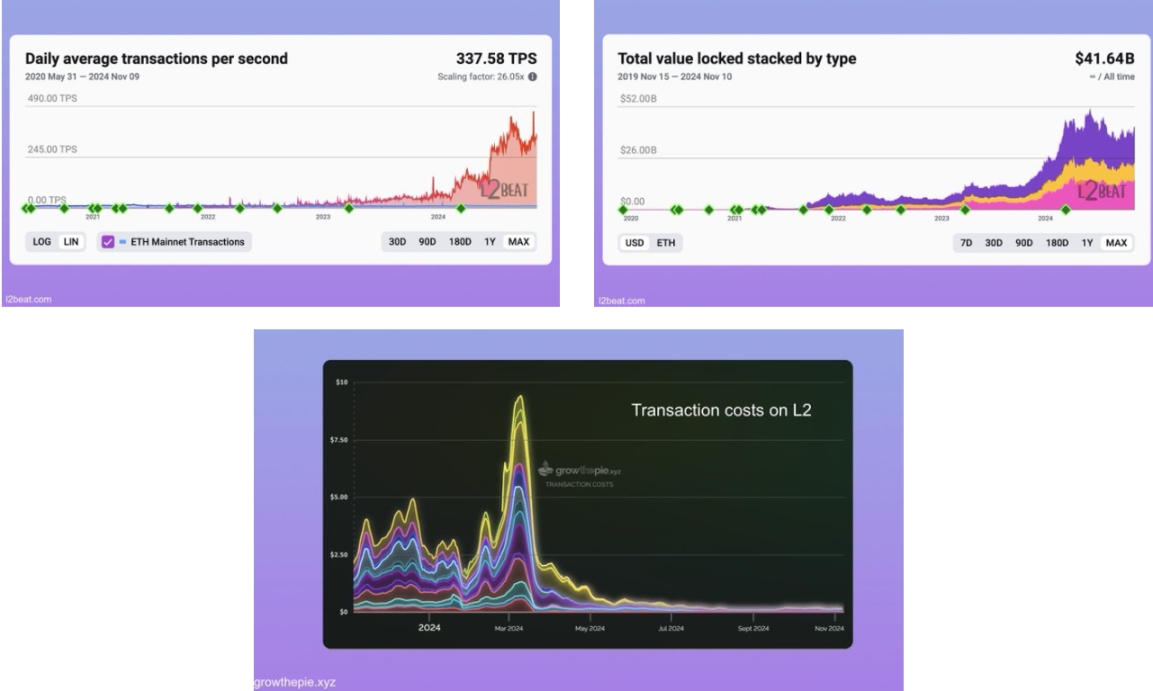
The second piece of evidence is: developers are starting to take advantage of the fact that different L2s can be customized for different purposes. This means Ethereum can absorb innovations from any other ecosystem and provide specific environments for different use cases. The third piece of evidence is: institutions and enterprises are launching L2s and bringing their communities into the Ethereum ecosystem. Ethereum is helping centralized institutions become more decentralized and bringing millions of people on-chain.

Finally, in recent years, we have even seen some previous L1s decide to transition to L2s within the Ethereum ecosystem to leverage Ethereum's security and community advantages. We are glad you are here—welcome to the infinite garden!
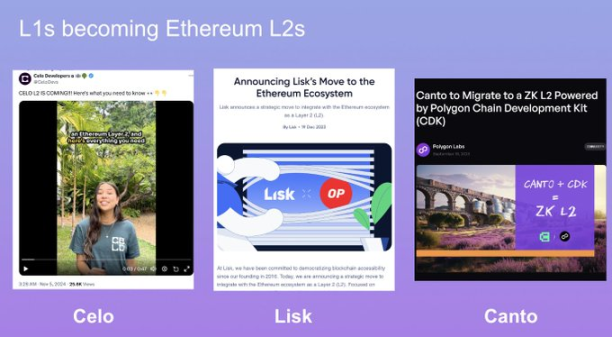
But as I said, we are not done yet. We still have two major tasks for the ecosystem: taking off the training wheels (achieving final form) and building interoperability.
Currently, most L2s are not in their "final form," and they will benefit from as much security and decentralization as possible. In fact, the images I previously showed are more like this:
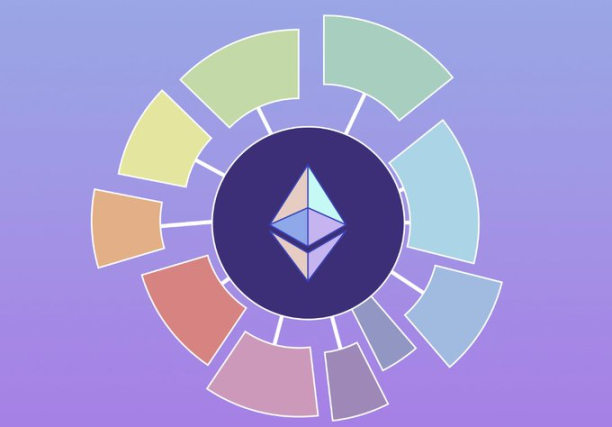
We typically refer to these as "phases," and you can learn more about them on L2Beat, where each L2 is progressing towards Phase 2. There is much to be proud of; so far, two complete EVM L2s—Arbitrum and Optimism—have reached Phase 1, and more will certainly follow soon. Finally, thanks to L2 Beat for tracking, assessing, and publishing information about each L2's progress into Phase 2. You help the Ethereum ecosystem better understand itself and hold the community accountable for our ambitious goals.
The second task is interoperability and user experience. Using L2s right now is not as easy as one might imagine. Transferring from one L2 to another and then sending to someone in the entire ecosystem—this experience is far from what it should be. Instead, it needs to feel more like a simple, interoperable network that feels like one ecosystem because it "is" one ecosystem.
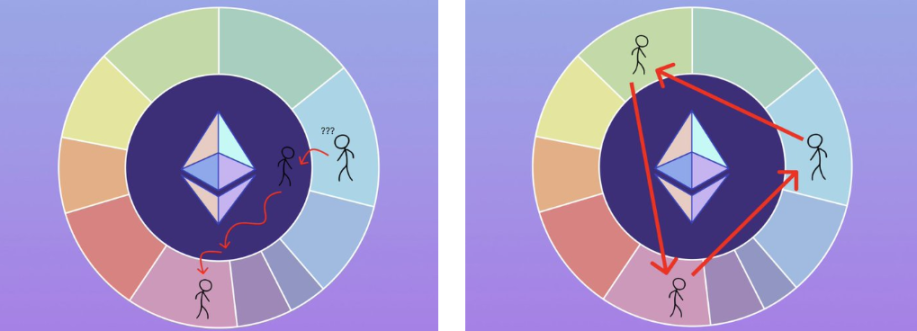
Fortunately, there are hundreds of people in the ecosystem working towards this goal. Soon we will have addresses that can be used anywhere, allowing easy transfers from one L2 to any other L2, and we will be able to easily use light clients to validate L2s.
Community
To understand the state of Ethereum today, we must talk about ourselves! The Ethereum community has grown so large and diverse that it is hard to comprehend. We can be users of Ethereum applications, ETH holders, application developers, protocol researchers, client developers, L2 developers and commentators, stakers and re-stakers, Degens and Regens, cypherpunks, activists and radicals, artists, musicians and writers, educators, translators and students, complete newcomers and seasoned users, and so on.
One incredible feature of the Ethereum community is its true internationalization. There are multiple user and enthusiast communities in every region of the world, as well as developers contributing to applications, L2s, and R&D. There is nothing better than this. But our community has another quality that is not so obvious. I don't have fancy charts to prove this, but perhaps you have already noticed. Over the past few years, our community has not only grown larger but has also deepened; it has matured.
By 2024, many of us understand that this is not a sprint but a marathon. We are putting down roots and preparing for the long term. We are building lasting organizations and companies, nurturing the next generation, and we have gained the confidence to plan for success.
So—what story does Ethereum tell in 2024? I see the beginning of a virtuous cycle. We are growing, and this growth is testing us and pushing Ethereum's infrastructure to its limits, and then we build like this. Better infrastructure can do bigger things, opening up new phases of growth. The interaction between adoption, growth, infrastructure, and growth again attracts a community of people who need what Ethereum can offer, want to plant their own seeds, and hope to build an entire community for the next generation.

We cannot be complacent. There are many challenges to solve. But remember: Ethereum encounters challenges first because it has come the farthest.
免责声明:本文章仅代表作者个人观点,不代表本平台的立场和观点。本文章仅供信息分享,不构成对任何人的任何投资建议。用户与作者之间的任何争议,与本平台无关。如网页中刊载的文章或图片涉及侵权,请提供相关的权利证明和身份证明发送邮件到support@aicoin.com,本平台相关工作人员将会进行核查。




